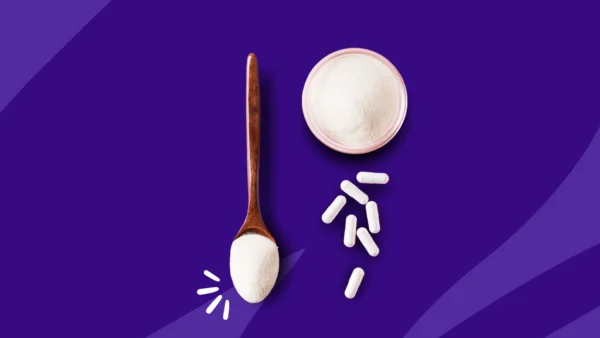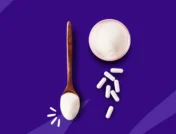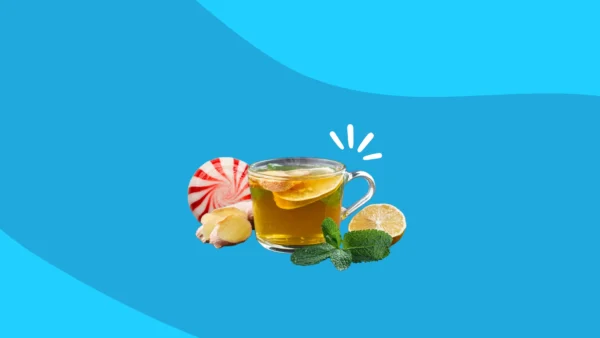Acne, also known as acne vulgaris, affects more than 50 million people in the U.S., according to the American Academy of Dermatology Association. It is an inflammatory skin condition most common in adolescents and young adults. While acne does not pose a serious health risk, the condition can lead to scarring, poor self-image, emotional stress, and lower quality of life.
Interestingly, there’s a relationship between your diet and acne. “Inflammation and hormone shifts can be influenced by diet,” says Dana Ellis Hunnes, Ph.D., RD, a senior clinical dietitian at UCLA medical center and author of Recipe for Survival. “The foods we eat can increase or decrease inflammation in the body, depending on the type and quality of the food. Food also affects our hormones, such as estrogen, testosterone, and insulin.” These hormone shifts and inflammation may play a role in acne development.
How does diet affect acne?
Acne breakouts vary by the person. They can appear as blackheads, whiteheads, cysts, and pimples on the face, back, chest, and shoulders. The skin has millions of openings called pores. Each pore contains a hair follicle. Acne results when hair follicles (and pores) clog with sebum (natural oil produced by the sebaceous glands), dead skin cells, and bacteria. Various factors may cause your pores to become blocked, such as an increase in the activity of certain hormones—androgens (male sex hormones) and insulin-like growth factor-1 or IGF-1 (growth hormones)—which contribute to the excess production of sebum.
Diet also plays a role in acne development. A Western diet has often been implicated. Studies show that certain people, such as the Canadian Inuit, South African Zulus, and Japanese Okinawans, historically had no record of acne until they adopted Western diets—high in processed foods, dairy, and refined carbohydrates.
“True acne is the interplay of hormonal triggers to increase oil and sebum in our pores and a bacteria called Cutibacterium acnes that triggers inflammation,” says Erum N. Ilyas, MD, a board-certified dermatologist and founder of AmberNoon. “For food to play a role in the development of acne, it would likely need to either impact our hormones, impact the bio flora on our skin to allow acne-related bacteria to overgrow, and inflame our skin directly in the manner that Cutibacterium can.”
According to experts, foods containing a high glycemic load (high amounts of carbs that increase blood sugar quickly) and milk products may lead to the release of insulin and insulin-like growth factors. These two hormones can trigger or worsen acne by producing excessive sebum. Also, increased carbohydrate intake has been linked to increased inflammation which may lead to breakouts. On the other hand, a diet consisting of omega-3 fatty acids reduces acne due to its anti-inflammatory properties. More research is needed to confirm the link between diet and acne.
5 foods that help with acne
There are many foods that are great for skin health. Here is a review of five foods that are good for acne with a focus on managing your symptoms.
1. Low glycemic index foods
The glycemic index of a food is a term used to describe foods that increase blood glucose levels two hours after you have eaten.
“Low glycemic foods cause a slower, more gradual rise in blood sugar levels,” says Alpana Mohta, MD, certified dermatologist and medical advisor for BetterGoods.org. “This is beneficial to people with acne because high blood sugar levels can lead to inflammation and clogged pores. Eating low glycemic foods such as whole grains [such as brown rice], nuts, legumes (beans, peas, and lentils), fruits, and vegetables helps keep blood sugar levels steady, reducing the chances of breakouts.”
This is because foods with a low glycemic index reduce the activity of androgen hormones and IGF-1. They also reduce blood sugar levels so as not to trigger inflammation—which makes oil clog the pores and cause acne. “Additionally, these foods are rich in antioxidants and other essential vitamins and minerals that can help protect the skin from damage. Therefore, an eating plan consisting of low glycemic foods is beneficial for those with acne-prone skin,” Dr. Mohta explains.
2. Omega-3 fatty acids
Omega-3 fatty acids are found in fatty fish like salmon, mackerel, and sardines. Foods high in omega-3 fatty acids decrease the production of acne-activating substances—IGF-1. As already stated, IGF-1 causes excess oil production and blockage of follicles. For this reason, it is expected that eating omega-3-rich foods may help decrease acne. What’s more, eicosapentaenoic acid (a type of omega-3 fatty acid derived from fish oils) decreases the synthesis of leukotriene B4—a substance that causes inflammation and acne.
3. Zinc-rich foods
Zinc is an essential micronutrient for maintaining healthy skin. Indeed, studies suggest zinc can destroy the acne bacteria—Cutibacterium acnes. It has also been shown in some earlier clinical trials that some people with acne had zinc deficiency, and when treated with zinc supplements, they saw an improvement in their condition. Hence, consider incorporating zinc-rich foods such as oysters, avocados, cereal, and nuts into your diet.
4. Antioxidant-rich foods
Antioxidants are highly recommended for people treating acne and other skin blemishes. Some familiar antioxidants include vitamins C, beta-carotene, selenium, and manganese. These antioxidants decrease reactive inflammatory substances usually found in patients with acne. For instance, catechins, an antioxidant found in green tea, inhibits sebum production. And resveratrol found in red grapes, red wine, peanuts, and mulberries has innate properties that promote clear skin. Resveratrol is an antioxidant that destroys Cutibacterium acnes.
5. Vitamin A- and E-rich foods
Some notable vitamins for maintaining a healthy skin include, vitamins A and E. Vitamin E is a fat-soluble vitamin that protects your cells from damage and helps your skin retain moisture. Vitamin A is also another fat-soluble vitamin, its derivative retinoids regulate the function of the sebaceous glands and limit sebum production. Researchers observed a relationship between low levels of vitamins A, and E in patients with severe cases of acne. And, when treated with vitamin A and E, the patients saw an improvement in their acne condition. Hence, consider incorporating vitamins A and E in your acne diet. Choose vitamin A sources such as eggs, liver, dark leafy greens, and carrots. For adequate vitamin E, opt for spinach, broccoli, and other green vegetables.
5 foods to avoid for acne
While it may not be necessary to eliminate certain foods from your diet, Hyemin Pomerantz, MD, board-certified dermatologist with VivaSkin, advises that if you notice certain food items trigger acne flare-ups (e.g., getting acne every time you drink milkshakes), avoid the potential culprit for a few months and see if it indeed reduces the severity of your skin problems. Keeping a food and acne journal may be helpful to notice your personal triggers.
1. High glycemic index foods
“Digesting food increases sugar levels in the bloodstream, and high glycemic foods cause the spike of blood sugar levels very quickly,” Dr. Pomerantz says. “Blood sugar spikes cause hormonal cascades leading to increased sebum production. A lot of sebum means more clogged pores and food sources for bacteria living in our pores, leading to worsening acne. In addition, long-term rapid spikes of blood sugar also increase inflammation throughout the body, and a high inflammatory state in the body can worsen acne.”
Consider limiting white bread, cornflakes, puffed rice, potato chips, white potatoes or fries, doughnuts or other pastries, sugary drinks such as soda, and white rice.
2. Dairy
“Dairy products contain hormones that can trigger breakouts. Milk’s natural job is to increase growth; it contains anabolic steroids, growth hormones, and other growth elements that stimulate acne.” Dr. Mohta says. “Dairy can also increase inflammation in the body, leading to increased clogged pores and acne flare-ups. While it is not necessary to completely avoid dairy if you have acne, it is important to reduce or eliminate any foods that may cause an imbalance in the skin microbiome.” What’s more, a study found that skim milk is more likely to cause acne when compared to other dairy like whole milk and low-fat milk.
3. Dark chocolate
“Dark chocolate comes in various levels of cacao, and it can still contain cow’s milk, which also has been linked to acne breakouts,” says Dr. Pomerantz.
One small study found that when consumed in average amounts for four weeks, dark chocolate can worsen acne in male participants with acne-prone skin. However, the research remains inconclusive because the study involved only a small group of people (25 men) who already had acne, and just one brand of chocolate was used for the trial.
4. Iodine
Iodine is a mineral found in some foods like table salt, and seaweed. Sometimes, acne may result after consuming foods containing iodine. And, this type of acne is identified by the sudden appearance of many papules. A 2010 study investigated the association between acne and dietary patterns between two groups—one group had acne, while the other group didn’t have acne. The researchers found that in the acne patients, consumption of a high iodine diet, such as seaweed, appeared to play a role in the worsening of acne.
5. Fatty foods
Limit your intake of fatty foods, particularly foods with saturated and trans fat which are found in—lamb, beef, pork, butter, milk, fried foods, and fast foods. Diets high in saturated and trans fat have been linked to worsening acne. Plus, consuming high amounts of unhealthy dietary fat (e.g., saturated fat) can affect your immune system, cause inflammation through a number of pathways, and contribute to acne.
Other ways to manage acne
Now that you know what to eat and to avoid in your acne diet, here are some other options to help you manage your symptoms.
Take care of your skin properly
In treating acne, it’s important to adopt a healthy, daily skincare routine such as:
- Use non-comedogenic skincare products—products containing ingredients that won’t clog or block the pores.
- Use mild skin cleansers. Avoid scrubs and harsh soaps.
- Avoid excessive scrubbing of the skin. Gentle massage with fingertips is sufficient. Don’t pick acne breakouts as this may exacerbate scarring.
- Use soap-free face wash and oil-free moisturizers and sunscreens as advised by your dermatologist.
- Practice regular, gentle exfoliation to remove dead skin cells, dirt, and oil that can clog pores and lead to breakouts. “It is important to be gentle when exfoliating as aggressive scrubbing can irritate the skin and cause further inflammation,” Dr. Mohta says. “Exfoliating regularly also promotes cell turnover, which leads to brighter, more even-looking skin.”
RELATED: Acne scar treatments
Manage stress levels
According to Dr. Mohta: “Reducing stress levels can help clear acne by reducing inflammation in the body. Stress can trigger several hormones that promote inflammation, leading to breakouts. Also, stress can cause us to reach for unhealthy foods or skip meals altogether, which can negatively impact skin health.”
Get enough sleep
Get enough sleep regularly is vital for healthy skin, and good sleep is essential for maintaining skin integrity. Research suggests that getting enough sleep can strengthen your immune system and aid collagen production. Collagen is the main component in your skin that keeps it in good condition. Additionally, a study published in the Journal of Clinical and Experimental Dermatology suggests that after exposure to sunlight, good sleepers had significantly better recovery from erythema and were more satisfied with their skin appearance.
Hydration
Dry skin is more likely to lead to acne. Drinking adequate water lowers inflammation and reduces acne, says Hunnes.
Supplements
Vitamin A (and retinoids), vitamin C, vitamin D, and vitamin E supplements are part of an effective multimodal approach to managing acne vulgaris. These supplements provide several benefits, such as forming new skin cells, decreasing sebum production, preventing pore blockage, anti-inflammatory effects, and skin hydration. Fish oil and mineral supplements like zinc and selenium are also beneficial in treating acne flare-ups.
Though more research is needed, probiotic supplements have proven effective in treating acne. Probiotic supplements containing Lactobacillus casei, Lactobacillus plantarum, Lactobacillus gasseri, and Lactobacillus lactis have been shown to restrain the growth of the acne bacteria—Cutibacterium acnes. In a 2013 study published in the Journal of Cutaneous Medicine and Surgery, the researchers observed that not only were probiotic supplements efficient in treating acne, but they also reduced the inflammatory side effects that patients experienced when they used antibiotics to treat acne.
Medications
The choice of acne treatment varies depending on your age, the site affected by acne, the appearance of the acne, and its severity.
For mild to moderate acne, topical medications (applied directly on the skin) such as topical retinoids (tretinoin, tazarotene, adapalene, and trifarotene) may be recommended. These medications are derived from vitamin A, and they reduce clogging of the follicles and inflammations. But, they should not be used during pregnancy or lactation because they can cause fetal abnormalities. When using topical retinoids, you can expect side effects like skin dryness, flaking, erythema, burning sensation, and irritation.
Other topical anti-acne medications include clindamycin or erythromycin, dapsone, azelaic acid, benzoyl peroxide, and clascoterone. Topical steroids may help decrease redness but do not decrease acne lesions.
For the severe inflammatory type of acne that is not responding to topical retinoids and also for acne located on your back, your physician may recommend oral antibiotics like tetracyclines (doxycycline, minocycline, sarecycline). Tetracyclines should be taken on an empty stomach with a full glass of water, as food may affect how these medications work.
Hormonal treatment with estrogen may be recommended for young women of adolescent age who have hormonal acne. Estrogen inhibits the effects of androgens on your sebaceous glands so as to reduce acne. Combination birth control pills contain estrogen and often help decrease acne.
When to see a doctor for acne
“The relationship between diet and acne is not as clear cut as we would like it to be because acne is a condition that can get better or worse without an obvious trigger,” says Dr. Pomerantz. “It’s like flare-ups that can happen even though you didn’t do anything differently about your routine.”
It is always a good idea to see your physician before modifying your diet and for severe symptoms of acne. Most family physicians and pediatricians who care for adolescents are well trained in acne treatment.











